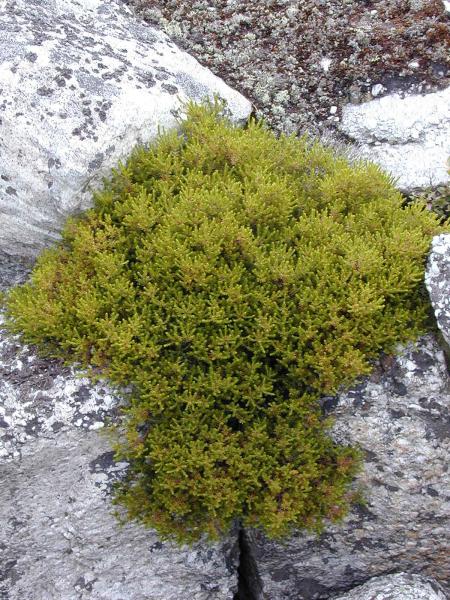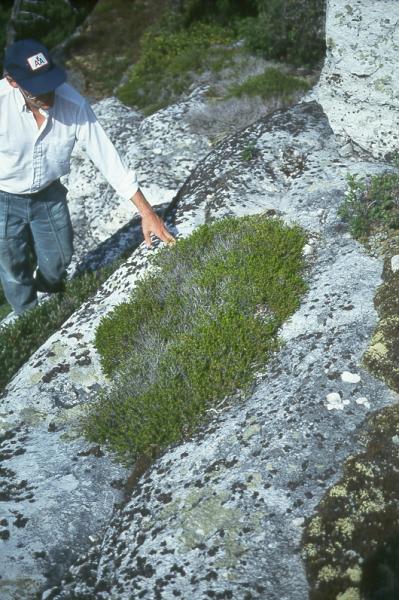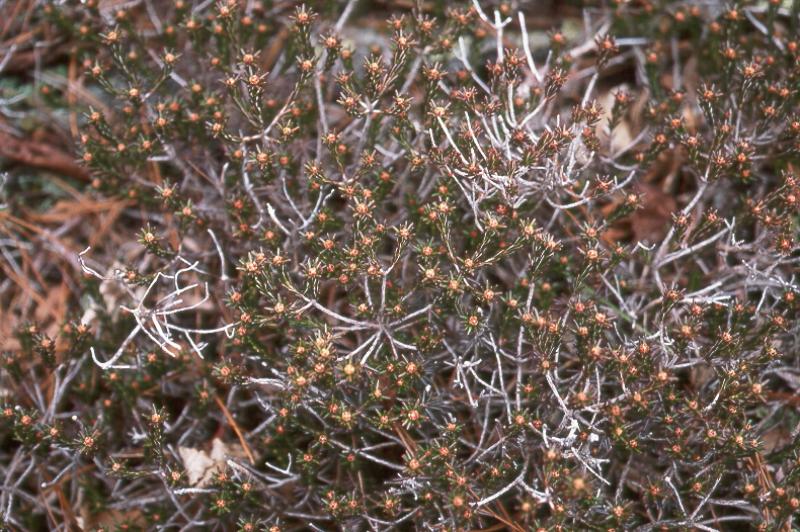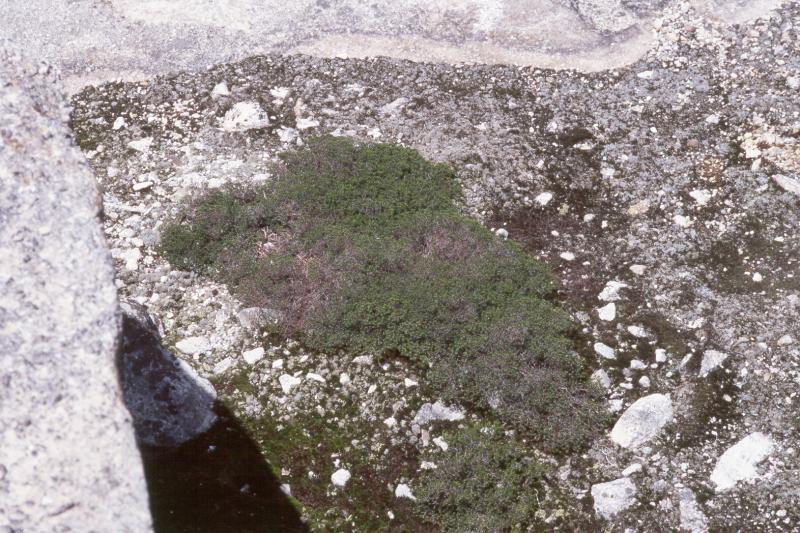Broom Crowberry
Corema conradii (Torr.) Torr. ex Loud.
- Class
- Dicotyledoneae (Dicots)
- Family
- Ericaceae (Heath Family)
- State Protection
- Endangered
Listed as Endangered by New York State: in imminent danger of extirpation in New York. For animals, taking, importation, transportation, or possession is prohibited, except under license or permit. For plants, removal or damage without the consent of the landowner is prohibited.
- Federal Protection
- Not Listed
- State Conservation Status Rank
- S1
Critically Imperiled in New York - Especially vulnerable to disappearing from New York due to extreme rarity or other factors; typically 5 or fewer populations or locations in New York, very few individuals, very restricted range, very few remaining acres (or miles of stream), and/or very steep declines.
- Global Conservation Status Rank
- G4
Apparently Secure globally - Uncommon in the world but not rare; usually widespread, but may be rare in some parts of its range; possibly some cause for long-term concern due to declines or other factors.
Summary
Did you know?
The New York plants on Ulster County's Shawangunk Ridge represent the only non-coastal site in the world where this plant grows naturally. The discovery of this population in 1881 created an exciting stir within the botanical community. Some traveled hundreds of miles to see this non-coastal population. Even today, this Corema population attracts many interested botanists and naturalists every year.
State Ranking Justification
There are only two known populations that are present on the same ridgeline in the Shawangunks. This may later be merged into a single meta-population with two sub-populations. These plants have been closely monitored since 1881. There is an historical report from Long Island, but numerous searches for it have proved unsuccessful. Besides possible reductions due to deer browse and trampling, the known populations are well-protected. The New York plants on Ulster County's Shawangunk Ridge represent the only non-coastal site in the world where this plant grows naturally.
Short-term Trends
The plant population is fairly isolated and seems relatively stable at the present time. Some observations indicate that deer browse may be having a detrimental impact on these plants, with foot trampling adding to the problem. There is very little habitat for this plant to spread in the immediate area, so recruitment may be difficult. Elsewhere within the Shawangunks, potential habitat abounds.
Long-term Trends
There was only ever one verified location for this plant in New York and this has been somewhat stable since its discovery in the mid 1800s. Some decline has been experienced since the mid 1900s, and this has been attributed to significant deer browse.
Conservation and Management
Threats
The population is not highly threatened and fairly remote but browsing by deer continues to affect accessible plants. Hiking traffic is increasing because of mountain bike accessibility to the trailhead. Absence of fire may allow blueberries to spread into its habitat.
Conservation Strategies and Management Practices
There has been a long discussion to mark the trail through the portions of the populations that are more subject to trampling. This marking may involve placing small stones on both sides of the path to clearly mark the trail boundaries. This seems like a reasonable step. At a minimum, continue to monitor deer browse and hiker traffic.
Research Needs
There are no current research needs.
Habitat
Habitat
A low-growing evergreen shrub only known from a small region of the Shawangunks where it occurs along the ledges of open exposed siliceous rock (New York Natural Heritage Program 2004). Usually in sandy soil (Gleason and Cronquist 1991). Sandy or rocky soil; pine barrens (Newcomb 1977). Sandy pine barrens, sandhills and siliceous rocks (Fernald 1970).
Associated Ecological Communities
- Maritime heathland*
(guide)
A dwarf shrubland community that occurs on rolling outwash plains and moraine of the glaciated portion of the Atlantic coastal plain, near the ocean and within the influence of onshore winds and salt spray.
- Pitch pine-oak-heath rocky summit
(guide)
A community that occurs on warm, dry, rocky ridgetops and summits where the bedrock is non-calcareous (such as quartzite, sandstone, or schist), and the soils are more or less acidic. This community is broadly defined and includes examples that may lack pines and are dominated by scrub oak and/or heath shrubs apparently related to fire regime.
- Unpaved road/path
A sparsely vegetated road or pathway of gravel, bare soil, or bedrock outcrop. These roads or pathways are maintained by regular trampling or scraping of the land surface. The substrate consists of the soil or parent material at the site which may be modified by the addition of local organic material (woodchips, logs, etc.) or sand and gravel. Abandoned railroad beds where tracks have been removed are included here. One characteristic plant is path rush.
* probable association but not confirmed.
Associated Species
- Aronia arbutifolia (red chokeberry)
- Betula populifolia (gray birch)
- Carex tonsa (shaved sedge)
- Gaylussacia baccata (black huckleberry)
- Kalmia angustifolia
- Kalmia latifolia (mountain laurel)
- Melampyrum lineare (cow-wheat)
- Pinus rigida (pitch pine)
- Pteridium aquilinum var. latiusculum
- Quercus ilicifolia (scrub oak, bear oak)
- Quercus montana (chestnut oak)
- Quercus rubra (northern red oak)
- Vaccinium pallidum (hillside blueberry)
Range
New York State Distribution
This low-growing evergreen shrub is only known from the Shawangunk Mountains. The populations from the Shawangunks have long been reported and studied. While surveys in other areas where potential habitat exists have been conducted, no additional populations have been found. Potential areas to search for this plant are other similar locations within the Shawangunks and the pine barrens of Long Island.
Global Distribution
A low growing evergreen shrub that is mostly limited to coastal habitats (sandy soils, pine barrens, etc.) from Newfoundland south to New Jersey, but disjunct inland at the Shawangunk Mountains in Ulster County, NY.
Identification Comments
General Description
Corema is a low, dense, evergreen shrub usually less than half a meter tall that spreads out in the shallow soil between open rock formations. It is highly branched with tiny, narrow evergreen leaves, green above and white below, covering the branches. The separate male and female flower heads form in a rosette of leaves at the tips of the branches. There are no petals but the other flower parts give a purplish cast to the plant in early spring.
Identifying Characteristics
A dioecous (separate male and female plants) and very unique low growing and long-lived evergreen shrub with narrow and rigid foliage. The leaves are 3-6 mm long and thin. The fruit is a small drupe that resembles that of bearberry. This fruit is dry and juiceless when ripe. The flowers are in terminal heads with no calyx present. The purple stamens are conspicuous when in bloom.
Best Life Stage for Proper Identification
This evergreen shrub can be identified anytime. For verification, please take a photo of the plant including a close-up of leaves and stems.
Similar Species
Corema is in the same family as Empetrum and may be confused with it. We have two Empetrum species within New York and both are considered rare. All Empetrum species will have axillary flowers (usually solitary or only a very few) with 6-9 stigmas and 3 petaloid sepals, while the flowers of Corema are in small terminal heads with 2-5 (usually 3) stigmas and no calyx.
Best Time to See
The plants are vegetative and evergreen nearly year round. The flowers are present late April to early May. Surveys may be conducted anytime, year round.
- Vegetative
- Flowering
- Fruiting
The time of year you would expect to find Broom Crowberry vegetative, flowering, and fruiting in New York.
Broom Crowberry Images
Taxonomy
Broom Crowberry
Corema conradii (Torr.) Torr. ex Loud.
- Kingdom Plantae
- Phylum Anthophyta
- Class Dicotyledoneae
(Dicots)
- Order Ericales
- Family Ericaceae (Heath Family)
- Order Ericales
- Class Dicotyledoneae
(Dicots)
- Phylum Anthophyta
Additional Common Names
- Poverty Grass
Additional Resources
Best Identification Reference
Gleason, Henry A. and A. Cronquist. 1991. Manual of Vascular Plants of Northeastern United States and Adjacent Canada. The New York Botanical Garden, Bronx, New York. 910 pp.
Other References
Fernald, M.L. 1950. Gray's manual of botany. 8th edition. D. Van Nostrand, New York. 1632 pp.
Holmgren, Noel. 1998. The Illustrated Companion to Gleason and Cronquist's Manual. Illustrations of the Vascular Plants of Northeastern United States and Adjacent Canada. The New York Botanical Garden, Bronx, New York.
Mitchell, Richard S. and Gordon C. Tucker. 1997. Revised Checklist of New York State Plants. Contributions to a Flora of New York State. Checklist IV. Bulletin No. 490. New York State Museum. Albany, NY. 400 pp.
New York Natural Heritage Program. 2010. Biotics database. New York Natural Heritage Program. New York State Department of Environmental Conservation. Albany, NY.
New York Natural Heritage Program. 2024. New York Natural Heritage Program Databases. Albany, NY.
Newcomb, Lawrence. 1977. Newcomb's Wildflower Guide: An Ingenious New Key System for Quick, Positive Field Identification of the Wildflowers, Flowering Shrubs, and Vines of Northeastern and North-Central North America. Little, Brown and Company. Boston.
Reschke, Carol. 1990. Ecological communities of New York State. New York Natural Heritage Program, New York State Department of Environmental Conservation. Latham, NY. 96 pp. plus xi.
Weldy, T. and D. Werier. 2010. New York flora atlas. [S.M. Landry, K.N. Campbell, and L.D. Mabe (original application development), Florida Center for Community Design and Research http://www.fccdr.usf.edu/. University of South Florida http://www.usf.edu/]. New York Flora Association http://newyork.plantatlas.usf.edu/, Albany, New York
Links
About This Guide
Information for this guide was last updated on: September 8, 2004
Please cite this page as:
New York Natural Heritage Program. 2024.
Online Conservation Guide for
Corema conradii.
Available from: https://guides.nynhp.org/broom-crowberry/.
Accessed July 26, 2024.



